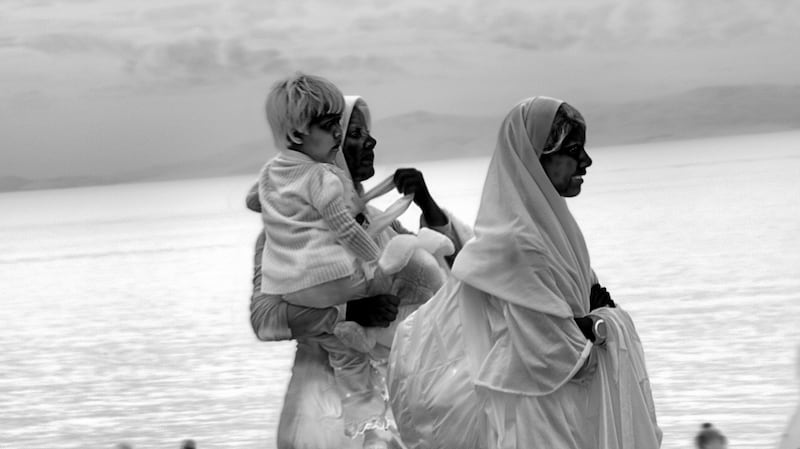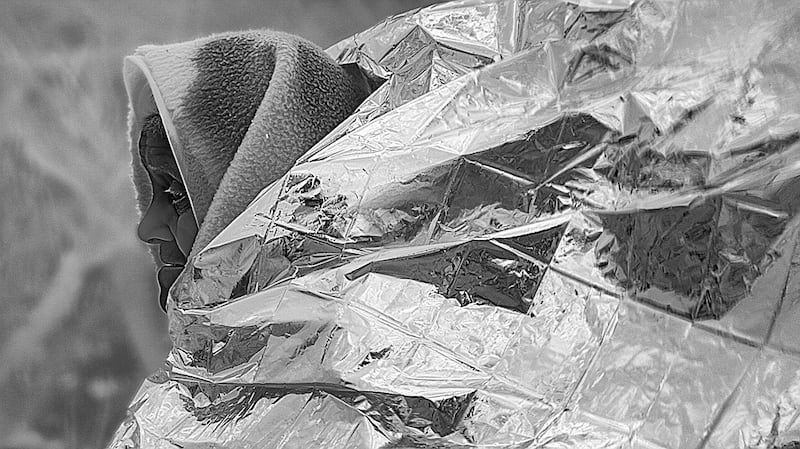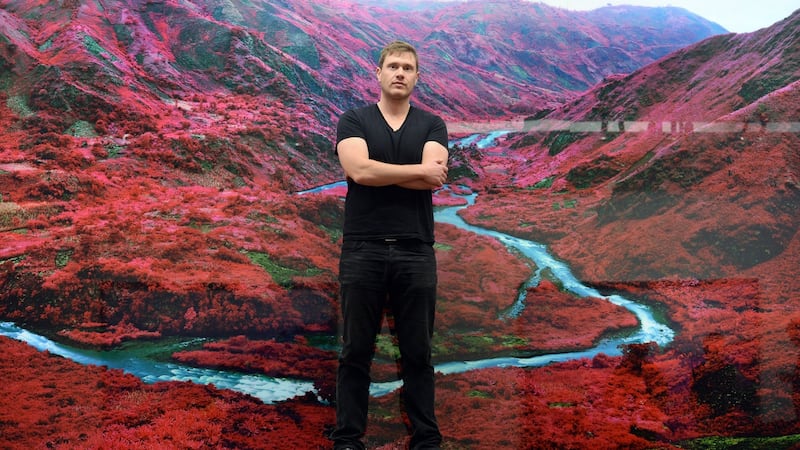Richard Mosse reminds me of a world I had almost forgotten. After a false start and a reschedule or two, we make contact on a Friday evening. The Irish artist has an unexpected break thanks to a delayed flight connection en route from Manaus in Brazil to New York. Travel in time of Covid is tough. He tells me, only half joking, that he has spent so much time quarantining in the home he bought in Co Clare he is on personal terms with the birds. "Birds have become a thing for me. Maybe that happens as you get older."
He's 41, but from the look of him, via Zoom to his hotel room, he doesn't exactly appear ready to settle down to a life of ornithology. Instead, his itinerary continues – from Congo to the Mediterranean, and Niger to the Brazilian Amazon. Why, when so many of us are chafing at staying put, is he on the move? The answer is simple: Covid may have put a pause to more frivolous trips, but there are still people who cannot help but move: the displaced, the fleeing refugees. And people still need to bear witness. Equally there are other injustices: in Brazil, deforestation, intensive mining and their attendant viciousness are all in the lens of Mosse's cameras.
So the grind of airport hotel layovers are nothing to the other, equally frequently forgotten worlds that Mosse draws attention to in his astonishingly arresting work. He describes the people whose disrupted lives he has encountered with a quiet passion. "Brazil is dying on its feet," he says. "Pfizer offered them vaccines and Bolsonaro turned them down." Instead, he continues, the Brazilian president sent soldiers to remote villages with chloroquine, the malaria drug Donald Trump had also falsely touted as a Covid cure. The soldiers carried coronavirus with them as they went.

Do such things make him furious or simply more determined? “A bit of both,” he says. “I have stories from the road I hope that can help in some way, but that’s not just a single thing. The idea of the artist going it alone is bogus. There are activists, scientists, human rights lawyers, journalists. Bit by bit, we can do something together.”
Mosse has none of that world-weary cynicism you sometimes find in people whose journeys take them to the harder places. Described to me once as a rock star, he certainly has a strong force of charm, even jet lagged via Zoom. He grew up in Kilkenny, son of mega-potters Nicholas and Susan Mosse, where the house was full of visiting artists and chat. “My parents were very specific about me not becoming an artist,” he says, wryly.

Instead, he studied English, before being drawn back to the art for which he had always felt an affinity. Extremely erudite, he wears his intelligence lightly, but there’s a laser-sharp focus both with the urgency of his ideas and on the world of his work. Representing Ireland at the 2013 Venice Biennale, his installation, The Enclave, attracted global attention and catapulted him to the upper tiers of the art world. The Butler Gallery’s Anna O’Sullivan curated that project, and so this latest Kilkenny exhibition is a homecoming, in more ways than one.
Still, his work has troubled me. When I see large glossy photography in a gallery, I always try to picture it small, to see if it still works or if it’s just the size and shine that beguiles. Mosse’s images pass this first test. But I’m still discomforted by how the pink-tinged military-grade film he used in the Congo works added a layer of unsettling beauty to his depictions of child soldiers.
The beauty is, he says, a deliberate part of his plan. “You want to make people taste their complicity, to disturb them a little bit, to remind them of their own agency. There’s no real looking in the mirror going on in some documentary photography. My intention is to hold up the mirror.” He explains how the gritty aesthetics of photojournalism lets us all off the hook.

These were ushered in by the likes of Magnum photographer Robert Capa, with his famously blurred images of the D-Day landings at Omaha Beach (a darkroom accident had led to the effects). Photojournalism, Mosse says, became deliberately lo-fi, allowing it to fly under the radar, hovering "between ethics and aesthetics and allowing the photographer to feel good about themselves. Congo is an extremely beautiful place, and what I'd really like is that the ambiguity is maintained, not explained away".
In these terms, the discomfort I feel at being lured by the beauty one of Mosse’s high-coloured images is part of the intention of the work. “Rather than deny we’re making an aesthetic object, why don’t we embrace the power of photography?” Seeing the Enclave originally, in the Irish pavilion with its balcony over a Venetian canal, I had been equally disquieted at the conditions of my life that allowed me to travel there in safety, to witness war turned into art before moving on to a glass of prosecco.
Pursuing this, I ask if he isn’t dismayed by the idea of these images hanging in the drawing rooms of the wealthy, where the pink tones of the particular military film technology he was using make images into glowing objects of desire. But, he counters, if you’re uncomfortable seeing the work in a privileged place, you’re also forced to note the imbalance of power that has created these spaces. “The alternative to looking at them is to look away,” he says, describing a desire to “almost weaponise the aesthetics. I want to push my work past that threshold, and that can be unsettling,” he says.
We talk about the ethics of travelling to trouble spots and the fine line that must lie in the intent as much as in the outcome of such journeys. There’s that pivotal etching in Francisco Goya’s series The Disasters of War (1863). The series shows torture, execution, rape and mutilation. One is simply captioned, Yo Lo Vi (I saw it). And that’s the point of the art: as soon as you see it, you become the “I”. Now it’s your job not to look away.
The themes of Mosse's successive bodies of work knit together. Climate change creates conflict, conflict causes migration, the actions of Big Oil and Gas cause climate change, and on it goes. "I find it shameful how we've failed refugees," he says. We've failed them legally too. He describes the international law laid down after the second World War, and how we've since been eroding those laws as deals are done to keep refugees out. "We're outsourcing the EU's refugee responsibilities to Turkey, South Sudan, Niger, Libya. We vote for these politicians [MEPs]. We can't look away from the things that are happening in our name."
This enforced migration is the subject of Incoming and Grid (Moria), the work on show in Kilkenny. "I want to make people feel something," Mosse says, visibly committed to his theme. "Each one of us is a potential refugee. If we allow their rights to be eroded, its our rights too." Although jet lagged, he quotes liberally, from Oscar Wilde to Susan Sontag. "People forget I'll spend three or four years in the field working on a project," he explains. "I become a bit of an expert."
Expert he may be, but I wonder how easy it is to get your hands on military surveillance and photographic technology. At this stage in Mosse’s career, it’s easier than you might think. The camera used to make Incoming detects thermal radiation, including the heat of a human body, from more than 30km away. Registering temperature rather than colour, the resulting images are black, white and grey, creating a quality that is sometimes cartoonish, sometimes ghostly in their shivery silvers. At a certain distance, mouths become black empty spaces to gasp for breath, to weep or scream.
"Sophie Darlington came up to me at an opening of Incoming at London's Barbican," Mosse says. The renowned wildlife photographer introduced both herself and another new camera. And, it seems, you can call up the manufacturers and ask if they have something in your size. The camera Darlington had discovered is used by mining companies to pinpoint mineral reserves underground, and creates a whole new aesthetic, with colours just enough out of true to give a sense of the surreal.
Our Zoom connection is failing. We switch off the video, but before we give up completely, Mosse’s voice comes back clearly. “Big Oil and Gas invested in building up the narratives of climate change denial. But the environmental movement is growing and that’s storytelling too. Storytelling is crucial. Black Lives Matter proves you can change the mindset of a whole country. We can fight this through storytelling.”
The Butler Gallery in partnership with Kilkenny Arts Festival presents the Irish premiere of Richard Mosse Incoming and Grid (Moria) as part of Brightening Air |Coiscéim Coiligh. Grid (Moria), June 11th-20th, and Incoming, June 11th-August 29th. butlergallery.ie/kilkennyarts.ie. Displaced, the first retrospective of Mosse's work is at Fondazione MAST, Bologna until September 19th, mast.org











